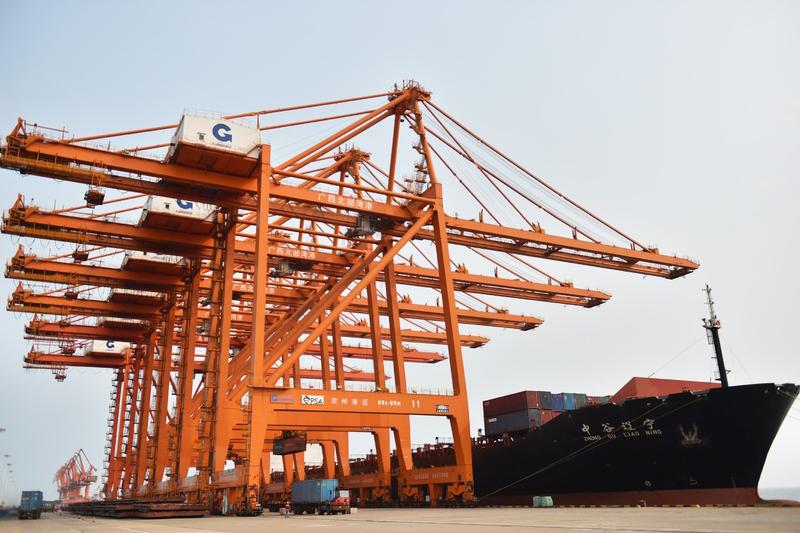 A cargo ship docks at Qinzhou Port in China-ASEAN Free Trade Area in Qinzhou, Guangxi Zhuang autonomous region, on July 11, 2020. (PHOTO / XINHUA)
A cargo ship docks at Qinzhou Port in China-ASEAN Free Trade Area in Qinzhou, Guangxi Zhuang autonomous region, on July 11, 2020. (PHOTO / XINHUA)
China’s efforts to build closer cooperation with ASEAN will benefit all countries in the region, contribute to greater integration in East Asia and bolster development needed for post-pandemic economic recovery, experts said.
“The cooperation between China and ASEAN is a key factor in keeping alive the narrative of economic interdependence in this region, which is essential for all governments as they seek to recover from the current pandemic-related economic recession,” said Aleksius Jemadu, a professor of international politics at Universitas Pelita Harapan in Indonesia.
An increase in trade and investment between China and the Association of Southeast Asian Nations in recent decades has produced tangible benefits for both sides, Jemadu said, adding that the two sides need to continue their cooperation to ensure East Asia is a growth engine for the global economy.
At a special summit to commemorate the 30th anniversary of China-ASEAN dialogue relations, chaired via video link by President Xi Jinping on Nov 22, the two sides upgraded their ties to a comprehensive strategic partnership.
During his speech, Xi said China and ASEAN have spearheaded economic integration in East Asia, promoted common development and prosperity, and delivered better lives to more than 2 billion people.
“Drawing wisdom from East Asian civilization, we have steered regional economic integration with an open mind,” Xi said.
Jemadu said cooperation between China and Indonesia can set a good example, as both countries have shown strong commitment to cooperation based on mutual respect.
State Councilor and Foreign Minister Wang Yi said on Dec 5 that China and Indonesia had led the way in vaccine cooperation, both regionally and globally, and set a model for major developing countries in terms of a joint COVID-19 response.
Wang made the comment when meeting with Indonesia’s Coordinator for Cooperation with China and Coordinating Minister Luhut Binsar Pandjaitan.
Souliya Mounnarath, a researcher at the Research Center on China at the National University of Laos, said the inauguration of the China-Laos railway on Dec 3 is “a perfect example” of the positive leadership role assumed by China in the ASEAN region, which shows China’s involvement in the East Asia integration.
The 1,035-kilometer-long railway connecting Kunming in Southwest China’s Yunnan province with Lao capital Vientiane is a docking project that links the Belt and Road Initiative and Laos’ national strategy to transform from a landlocked country into a land-linked hub.
BRI “provides ASEAN with a good opportunity for cooperation” by linking the bloc with China and other countries, said Mounnarath.
The 10-nation bloc can be a connector that brings together East Asian countries, as it is an important trade and investment destination in the region, said Kriengsak Chareonwongsak, chairman of the Nation-Building Institute in Thailand.
ASEAN remained China’s biggest trading partner in the first 11 months of 2021, data released on Dec 7 by China’s General Administration of Customs showed.
Bilateral trade reached 5.11 trillion yuan ($802 billion), up 20.6 percent year-on-year, and accounted for 14.4 percent of the total value of China’s foreign trade during the same period.
ASEAN became China’s largest trading partner in 2020, and China has maintained its status as the bloc’s largest trading partner for 12 consecutive years.
Kriengsak said strengthening the China-ASEAN relationship will benefit all countries in the region and promote faster integration, which is important to mitigate the pandemic-induced global slump and counter the rise of protectionism.
Lim Tai Wei, an adjunct senior research fellow at the East Asian Institute at National University of Singapore, said ASEAN can benefit from being a bastion of free trade and anti-protectionist sentiments.
Lim said the absence in East Asia of “beggar thy neighbor” policies — a country benefiting at the expense of others — exemplifies a new phase in bilateral ties in the region. In addition to economic cooperation, the region has shared vaccines, medical supplies and expertise to fight the COVID-19 pandemic.
“It shows that cooperation among East Asian countries did not break under extreme pressure and they did not practice vaccine nationalism or foment conflict,” he said.
The Regional Comprehensive Economic Partnership is poised to become a magnet for free trade in the region when it takes effect on Jan 1. The signing of the RCEP — the world’s largest free trade agreement — shows that the capacity of East Asian countries to cooperate has been enhanced rather than lessened by the pandemic, Lim said.
While peace and stability are key to regional development, countries can further promote mutual understanding through people-to-people exchanges including cultural, business and youth exchanges, he added.
Kriengsak from the Nation-Building Institute said it is also important for China and ASEAN to cooperate more on technological development to address the climate crisis as well as pandemic-related economic issues.
“Upgraded China and ASEAN ties can really be helpful for China and ASEAN and bring stronger East Asia integration,” said Kriengsak.


